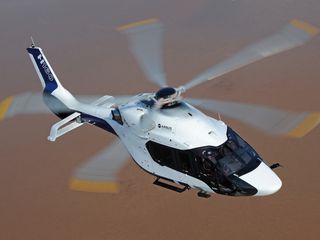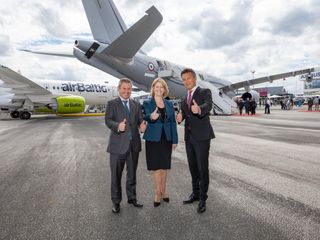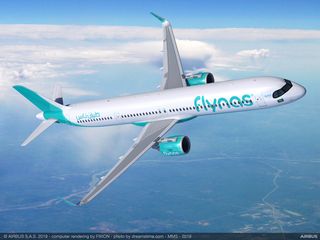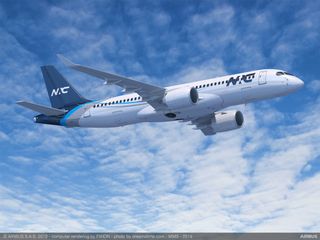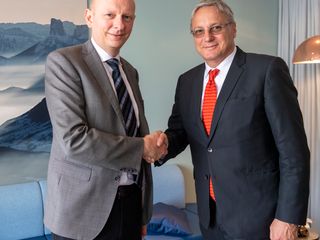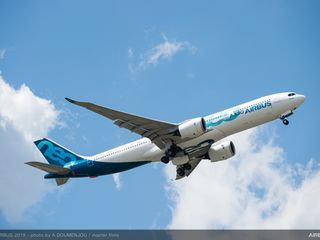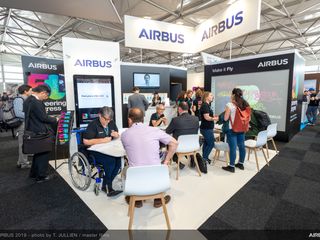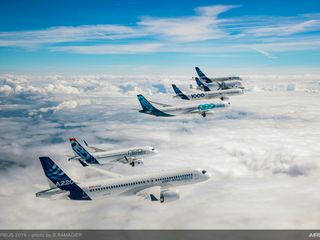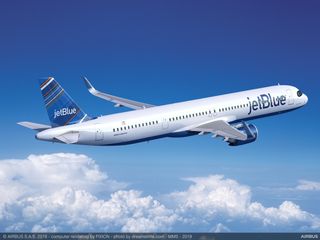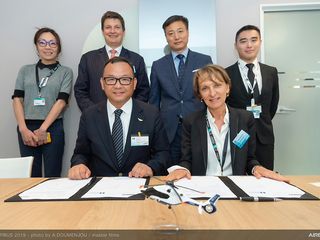Airbus recapped its Paris Air Show achievements on the event’s final fully professional day, underscoring strong endorsements for its jetliner families – including the newly-launched A321XLR (extra-long range) version; marking a major industrial milestone for Europe’s Future Air Combat System; and reinforcing Airbus Corporate Helicopters’ Chinese market presence with this country’s launch customer for the ACH160 rotorcraft.
Speaking to reporters at Le Bourget Airport, Chief Executive Officer Guillaume Faury and Chief Commercial Officer Christian Scherer said Airbus’ new business announced this week for a total of 383 aircraft (along with 375 conversions of existing aircraft orders) was a clear endorsement of the company’s jetliner families’ product strategy – supported by a very vibrant market.
“The number of orders and commitments received, along with the number and diversity of airlines and lessors, serves as a strong endorsement of our product strategy,” Scherer added, as demonstrated by the new business for both the single-aisle A320 product line and the new wide-body A330neo.
The single-aisle aircraft’s growing popularity
The extra-long-range single-aisle A321XLR made headlines with its official launch at the air show, followed by announcements of 48 orders and 89 commitments, as well as 112 conversions from existing A321neo bookings to the A321XLR version through the air show’s fourth day.
With an extended range of up to 4,700 nm, the A321XLR is the newest member of the A320neo Family and the next evolutionary step for Airbus’ single-aisle product line, responding to market needs for even more range and payload, generating more value for operators – while offering an enhanced passenger experience with the “Airspace by Airbus” cabin.
Other A320 Family members received 127 orders and commitments through today. “These results show the continuous interest in Airbus single-aisle aircraft despite an already-very solid order book and commitments out to 2024,” elaborated Scherer. “We are receiving endorsements from all market segments, including lessors, low-cost carriers as well as mainstream carriers.”
Airbus’ latest addition to its single-aisle product line – the A220 – won new business for 85 aircraft, further demonstrating customers’ interest in the efficient jetliners that are purpose-built for the 100-150 seat market. CEO Faury noted that the A220 made its first Paris Air Show appearance as a member of the Airbus commercial aircraft product lineup, with an airBaltic A220-300 on display.
Market-leading wide-bodies: two aircraft, four sizes
The week’s orders also reconfirmed the continuing popularity of Airbus’ wide-body A330, paced by the latest version – the A330neo, which gained a combined total of 24 orders and commitments in the longer-fuselage A330-900 configuration.
Reinforcing the A330neo’s market appeal is the aircraft family’s commonality with the Airbus’ A350 XWB, constituting the most modern and efficient wide-body product line. Its four members (the A330-800 and A330-900, along with the A350-900 and A350-1000) provide four optimally sized wide-body aircraft with seating capacities from 220 to 410 passengers and a range of more than 7,000 nm. They benefit from the latest propulsion technology and aerodynamic enhancements, while also providing an exclusive passenger experience with the modern “Airspace by Airbus” cabin, plus cockpit commonality for pilots.
The attributes of Airbus’ A330neo/A350 XWB wide-body jetliners were cited by Virgin Atlantic Chief Executive Shai Weiss when the carrier announced its order this week for 14 A330-900s, with options for six more – supporting its fleet renewal and expansion. “In addition to providing a 13% fuel reduction from our current A330-200 and A330-300 fleet, the A330neo operates with lower noise and has the commonality advantage with our A350 XWBs,” Weiss said. “This decision was a once-in-a-lifetime opportunity that sets the airline on a path for growth.”
A350 XWB technology applied to the A330neo includes the Rolls-Royce Trent family new engines and the latest aerodynamic features, such as new composite sharklets. The A330neo also benefits from proven profitability, exceptional operational flexibility on sectors from 30 min. up to 17 hrs. and 99.5% operational reliability of the A330, which has over 1,400 aircraft in service all over the world.
Looking into the future with FCAS
The Paris Air Show also served as the venue for a major European defence milestone, with Airbus and Dassault Aviation delivering their first Demonstrator Phase industrial proposal for the Future Combat Air System (FCAS). While briefing reporters, Guillaume Faury underscored the significant progress made during the show, “We are very happy to see Spain’s decision to join the French and German initiative and the partnership we have with Dassault being reinforced and going to the next step of the programme,” he told journalists.
The FCAS is a network-based, information-centric combat system that includes a new fighter aircraft and Remote Carriers (RCs). Bruno Fichefeux, the FCAS head at Airbus, said the programme must develop technologies that will be viable in 2040 and beyond – making the system that is open, flexible and adaptable to future upgrades and advancements.
Airbus Helicopters expands international partnerships
In other Paris Air Show activity, Airbus Helicopters announced that Shenzhen Eastern General Aviation Company has signed an agreement for an ACH160 – becoming the launch customer for this helicopter type in China. The ACH160 is a member of the Airbus Corporate Helicopters product line – and a variant of Airbus Helicopters’ innovative medium twin-engine rotorcraft designed to create added value for customers in performance, economic competitiveness, safety and comfort.
Additionally, Airbus Helicopters will explore potential cooperation projects with Turkish Aerospace, per a Memorandum of Understanding signed by Airbus Helicopters CEO Bruno Even and Turkish Aerospace President/CEO Prof. Dr. Temel Kotil.
Connectivity onboard, and across platforms
Another Airbus focus at the Paris Air Show was connectivity and the Internet of Things (IoT). Connectivity already is changing lives on Earth – and as these technologies are increasingly being used on aircraft, aviation is benefitting from connectivity across platforms, making the industry safer and more efficient.
With a unique experience that crosses the domains of aircraft, satellites and secure military communications, Airbus is working on harmonising platform connectivity and developing interoperable communication solutions. These solutions can be applied to such diverse platforms as jetliners, helicopters, drones, future VTOL (vertical take-off and landing) aircraft, satellites, command centres and mobile units deployed on the ground or at sea.
For connectivity in the air transport sector, Airbus aims to offer the same seamless experience aloft that people have with their mobile phones and devices on the ground – but with the reliability and cybersecurity standards of the aviation industry.
Airbus envisions using connectivity to enhance the passenger experience, while also keeping cabin personnel and flight crews informed of the on-board status – literally from nose to tail. Called the “Connected Experience by Airbus,” it includes such applications as real-time tracking of baggage loading in overhead bins while passengers embark, improving galley monitoring to track food and beverage stocks, performing predictive maintenance through the remote monitoring of lavatories, along with keeping watch on premium-class seats to ensure their functionality and signal problems in case of malfunctions.
An additional benefit of these technologies is improved operational efficiency, as faster data speeds will enable jetliners to gather and share more in-flight information with other aircraft, as well as ground teams and the air traffic system.
Underpinning this new era of connectivity is Skywise, which the company is evolving to serve as aerospace’s data platform of reference. With flexible and visual tools, Skywise enables airlines to store, access, manage and analyse data more efficiently while also benchmarking against other airline users’ trends. The Skywise platform provides all technology elements in one place – from data warehousing, visualisation and alerting to machine learning packages.
For additional information:
- Read more about the orders and commitments for the Airbus aircraft in today’s commercial update press release.
- Learn the details of Flynas’ order in the dedicated press release.
- Read about JetBlue Airways’ new orders.
- Learn more information on Nordic Aviation Capital’s A220 Family order.
- See the press release on details of Airbus Helicopters’ agreement with Shenzhen Eastern General Aviation Company for the ACH160.
- Read about Airbus Lockheed Martin’s reaffirmed tanker partnership.



